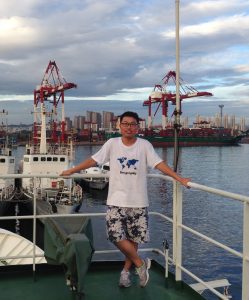Research Assistant
201 More Hall, Box: 352700
Department of Civil and Environmental Engineering
University of Washington
Seattle, WA, 98195-2700
Email: zchan@uw.edu
I finished my bachelor’s and master’s degree in School of Geographic and Oceanographic Sciences, Nanjing University, China. And I began to work on a PhD program with Alex Horner-Devine in the University of Washington since 2016 with Steve and Sylvia Burges Endowed Presidential Fellowship and an NSF project sponsorship.
Research Project
The current project I take is on wave supported gravity currents. The most interactive process for the continent and the ocean is the river discharge. By intuition, there is no doubt that sediment should come from the land in the shallow water region. However, numerous studies show that other than the igneous sediment by the submarine volcanos, much sediment in the deep ocean comes from the continent. But unlike the naughty coastal ocean, a child with so much energies of waves, tides and longshore currents, the deep sea is like a gentle lady, elegant and quiet. However, for such thousands-of-kilometer distance, how can the sediment moves to the deep sea? One might say the gravity matters since the depth increases. But the slope on the continental shelf is so small that pure gravity cannot make it. So what makes a large amount of sediment move in the silent deep ocean? The wave and tide tend to move sediment to the coast, but they have energy to resuspend sediment because of turbulence. When the sediment gets resuspended, the local density is bigger than the ambient water because sediment joins the party. Sediment moves downslope thanks to the density difference. Every small step for the sediment itself, one giant leap for the deep ocean. Since this kind of movement is supported by waves, it is called wave supported gravity currents. Detailed project introduction goes:
http://depts.washington.edu/uwefm/wordpress/home/research/gravity-currents/
“What makes me study science? I believe the most motivation is from curiosity on the nature – asking for WHY whatever new to me. I still remember that the first time I took a cruise was in a small fishing boat. Like a baby, I was curious about everything on the boat: how to set ADCP work, how to drive the boat, and how to prevent from seasick. But what I’m interested most is the motion of the water, why did the water moves in such a rhythmic way, and irregular at the same time? Sitting on the front deck, appreciating the romantic sunset, whistling Can You Feel the Love Tonight, staring at the naughty buoy, I find the ocean, reflecting the sunlight, seems to tell the story. Surface water waves, propagated like transformers, tell you the difference of viscosity of water comparing to the air quietly. Sometimes you might be lost into that scene, that the ocean suddenly becomes a blackboard, with velocity floating on the surface, saying hello with their phase speed. Studying science, you will find the nature satisfies all of your curiosity through the sparkling math expressions.” – Zhuochen Han
